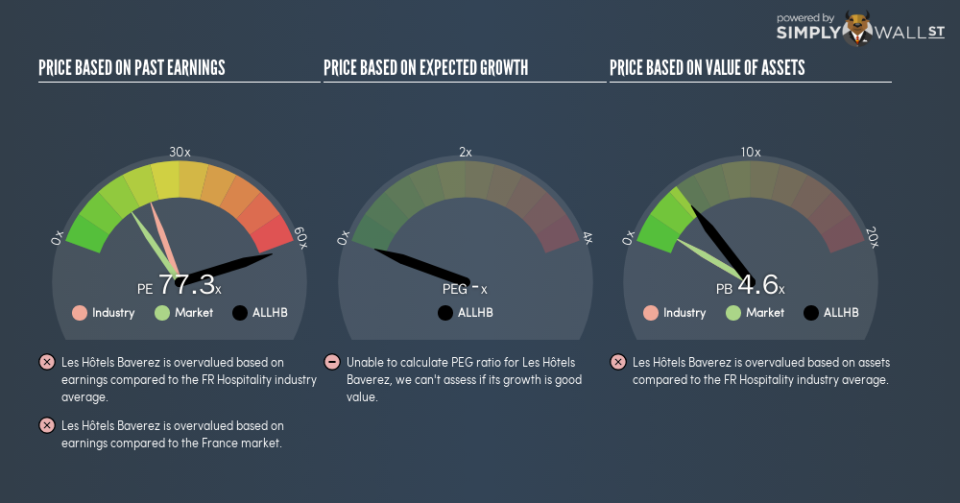Here’s What Les Hôtels Baverez SA’s (EPA:ALLHB) P/E Is Telling Us

This article is for investors who would like to improve their understanding of price to earnings ratios (P/E ratios). To keep it practical, we’ll show how Les Hôtels Baverez SA’s (EPA:ALLHB) P/E ratio could help you assess the value on offer. Les Hôtels Baverez has a P/E ratio of 77.33, based on the last twelve months. That is equivalent to an earnings yield of about 1.3%.
View our latest analysis for Les Hôtels Baverez
How Do I Calculate A Price To Earnings Ratio?
The formula for P/E is:
Price to Earnings Ratio = Price per Share ÷ Earnings per Share (EPS)
Or for Les Hôtels Baverez:
P/E of 77.33 = €68.5 ÷ €0.89 (Based on the trailing twelve months to June 2018.)
Is A High P/E Ratio Good?
A higher P/E ratio means that buyers have to pay a higher price for each €1 the company has earned over the last year. That is not a good or a bad thing per se, but a high P/E does imply buyers are optimistic about the future.
How Growth Rates Impact P/E Ratios
Earnings growth rates have a big influence on P/E ratios. When earnings grow, the ‘E’ increases, over time. That means unless the share price increases, the P/E will reduce in a few years. A lower P/E should indicate the stock is cheap relative to others — and that may attract buyers.
Les Hôtels Baverez increased earnings per share by a whopping 345% last year. And its annual EPS growth rate over 5 years is 24%. So we’d generally expect it to have a relatively high P/E ratio.
How Does Les Hôtels Baverez’s P/E Ratio Compare To Its Peers?
We can get an indication of market expectations by looking at the P/E ratio. The image below shows that Les Hôtels Baverez has a significantly higher P/E than the average (21.2) P/E for companies in the hospitality industry.
Les Hôtels Baverez’s P/E tells us that market participants think the company will perform better than its industry peers, going forward. The market is optimistic about the future, but that doesn’t guarantee future growth. So further research is always essential. I often monitor director buying and selling.
Don’t Forget: The P/E Does Not Account For Debt or Bank Deposits
The ‘Price’ in P/E reflects the market capitalization of the company. In other words, it does not consider any debt or cash that the company may have on the balance sheet. Theoretically, a business can improve its earnings (and produce a lower P/E in the future), by taking on debt (or spending its remaining cash).
Such expenditure might be good or bad, in the long term, but the point here is that the balance sheet is not reflected by this ratio.
Les Hôtels Baverez’s Balance Sheet
Net debt totals just 1.6% of Les Hôtels Baverez’s market cap. It would probably trade on a higher P/E ratio if it had a lot of cash, but I doubt it is having a big impact.
The Bottom Line On Les Hôtels Baverez’s P/E Ratio
Les Hôtels Baverez trades on a P/E ratio of 77.3, which is multiples above the FR market average of 15.1. While the company does use modest debt, its recent earnings growth is impressive. So it is not surprising the market is probably extrapolating recent growth well into the future, reflected in the relatively high P/E ratio.
Investors should be looking to buy stocks that the market is wrong about. If the reality for a company is better than it expects, you can make money by buying and holding for the long term. We don’t have analyst forecasts, but shareholders might want to examine this detailed historical graph of earnings, revenue and cash flow.
But note: Les Hôtels Baverez may not be the best stock to buy. So take a peek at this free list of interesting companies with strong recent earnings growth (and a P/E ratio below 20).
To help readers see past the short term volatility of the financial market, we aim to bring you a long-term focused research analysis purely driven by fundamental data. Note that our analysis does not factor in the latest price-sensitive company announcements.
The author is an independent contributor and at the time of publication had no position in the stocks mentioned. For errors that warrant correction please contact the editor at editorial-team@simplywallst.com.

